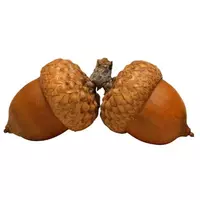Acorn nuts

We think most of the inhabitants of our latitudes are familiar with a nut like acorn. There is hardly anything surprising or unusual in this, because trees whose fruits are acorns everywhere grow in the territory of the Russian Federation, as well as in neighboring states. Acorns are syncarp fruits of plants that consist of a rigid leathery pericarp, as well as a plum, i. e. a cup-shaped organ that surrounds the fruit of some species of fruit-bearing trees.
Acorns are thought to be a distinctive feature of plants that belong to the Bukovs family. For this reason, the acorns are called the fruits of not only oak, but also chestnut, beech and other representatives of the family. However, for the vast majority of our compatriots, when mentioning the word acorns in front of their eyes, in 99% of cases a mighty oak tree will appear. We begin to get acquainted with oak nuts or acorns as a child.
Acorns are considered an excellent material for arts and crafts as well as creativity. However, in addition to aesthetic and external distinctive characteristics, acorns have other unique abilities that people have long used not only in cooking, but also in folk medicine. The distinctive healing properties of acorns are often used as an important ingredient in the manufacture of medicinal products.
The beneficial properties of acorns have been known to mankind for several millennia. As a result of archaeological excavations, experts found in Japan the remains of acorns, well-preserved, like other items of kitchen utensils, as well as ingredients that people used in ancient times for cooking. Another archaeological find in the Mediterranean region, which is 5, 000 years old, suggests that acorns began to be used as food from the very beginning of the development of human civilization.
In ancient times, acorns were baked in stoves that were used for cooking. However, not only taste, but also consumer characteristics of acorns were used by people. Nuts have earned popularity and are in stable demand due to the unique vitamin-mineral composition of acorns, which is enriched with a large number of useful compounds of natural origin. Both fresh and dried acorns are used in cooking.
In addition, in Asian countries, for example, in Korea, acorns are made into flour, which is used in the process of making bakery products and pastries, as well as for the manufacture of some types of national confectionery and sweets (tothorimuka jelly). Often acorns act not only as a healthy and tasty natural food product. Acorns are used in heraldry, as well as in departmental symbols. In addition, acorns are depicted on some of the highest military awards of a number of states.
acorns 387 kCal
Energy value of acorn nuts (Ratio of proteins, fats, carbohydrates - ju):
Proteins: 24 g (~ 96 kCal)
Fats: 207 (~ 1863 kKal)
Carbohydrates: 157g (~ 628 kCal)
Energy ratio (bj | y): 25% | 481% | 162%
 Español
Español Français
Français Português
Português Русский
Русский 简体中文
简体中文 繁體中文
繁體中文 日本語
日本語 한국어
한국어 العربية
العربية Türkçe
Türkçe Қазақ
Қазақ Deutsch
Deutsch Italiano
Italiano Українська
Українська
